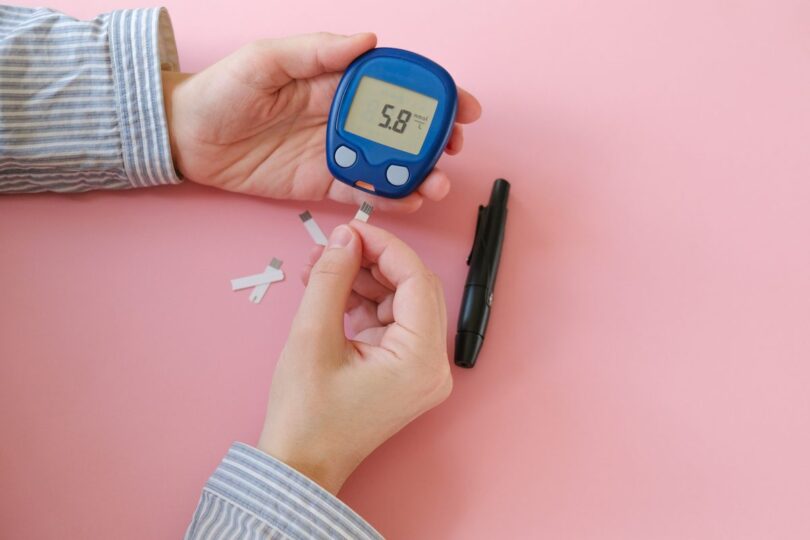A sugar normal level for a healthy adult is between 70 and 99 milligrams per deciliter (mg/dL) or 3.9 and 5.5 millimoles per liter (mmol/L). However, these levels can vary depending on the time of day and the individual’s current health status. For example, blood sugar levels are typically lower in the morning and higher after meals.
Table of Contents
What are the different types of sugar testing methods?
There are several different types of sugar testing machine and methods available, including:
- Finger-prick test: This is the most common type of sugar testing method. It involves pricking the finger with a small needle to obtain a drop of blood, which is then placed on a test strip and inserted into a glucose meter to measure the blood sugar level.
- Continuous glucose monitoring (CGM): This involves wearing a small sensor under the skin that continuously measures the blood sugar level and sends the data to a receiver or smart device.
- A1C test: This test measures the average blood sugar level over the past 2-3 months. It is done in a lab and no fasting is required.
- Oral glucose tolerance test (OGTT): This test is used to diagnose prediabetes and diabetes. It involves measuring the blood sugar level after fasting and then again after drinking a sugary liquid.
What are the different types of sugar testing machines?
- Glucose meters: These are small handheld devices that use a test strip to measure the blood sugar level. The test strip is inserted into the device and a drop of blood is placed on it. The device then displays the blood sugar level in mg/dL or mmol/L.
- Continuous glucose monitoring systems: These systems include a sensor that is worn under the skin and a receiver or smart device that displays the blood sugar level in real-time.
- A1C test kits: These kits are used to measure the average blood sugar level over the past 2-3 months, no fasting is required.
How to properly use a glucose meter
- Wash your hands: Start by washing your hands with soap and water to remove any dirt or germs that may be on your skin.
- Prepare the meter: Turn on the glucose meter and follow the manufacturer’s instructions for preparing the test strip.
- Prick your finger: Use the lancing device to prick the side of your fingertip and gently squeeze to obtain a drop of blood.
- Place the blood on the strip: Gently touch the edge of the test strip to the drop of blood to collect it.
- Wait for the results: Wait for the meter to display the blood sugar level. The time it takes for the results to appear can vary depending on the meter.
- Record the results: Record the results of the test in a logbook or an app.
How to properly use a continuous glucose monitoring system
- Insert the sensor: The sensor is inserted under the skin using a special applicator.
- Wear the transmitter: The sensor is connected to a small device called a transmitter that is worn on top of the skin. The transmitter sends the blood sugar level data to the receiver or smart device.
- Calibrate the system: Calibrate the system as per the manufacturer’s instructions. It requires it to be done occasionally.
- Check the blood sugar level: Check the blood sugar level on the receiver or smart device as needed. The device will show a continuous glucose reading, trend arrow, alerts, etc.
- Change the sensor: The sensor should be replaced every 3-7 days as per the manufacturer’s instructions.
- Check for sensor accuracy: Check for the accuracy of the sensor readings now and then, if it’s not accurate contact the manufacturer.
How to properly store and maintain the sugar testing machine
- Store in a cool and dry place: Store the glucose meter and test strips in a cool, dry place, and protect them from direct sunlight and extreme temperatures.
- Check the expiration date: Check the expiration date on the test strips and do not use them if they have expired.
- Keep the meter clean: Wipe the glucose meter with a damp cloth and dry it thoroughly before and after use.
- Follow the manufacturer’s instructions: Follow the manufacturer’s instructions for cleaning and maintaining the glucose meter, CGM, or A1C test kit.
How to Interpret the results of the sugar testing machine
The results of a sugar testing machine will typically be given in mg/dL or mmol/L. The normal range for a healthy adult is between 70 and 99 mg/dL or 3.9 and 5.5 mmol/L. However, these levels can vary depending on the individual and the time of day. It’s always good to have a background of your health history, current medication, and any recent symptoms to interpret the results of the sugar testing machine.
Conclusion
Sugar testing machines, such as glucose meters and continuous glucose monitoring systems, are important tools for managing diabetes and monitoring blood sugar levels. Use these machines properly, store and maintain them correctly, and interpret the results properly. By following the proper guidelines, individuals can better manage their diabetes and maintain good blood sugar control.
